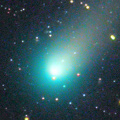
|
It brightened rapidly in outburst in mid October. Now it is bright as
8.3 mag (Apr. 11, Marek Biely). It keeps 8-9 mag until early summer. In
the Northern Hemishpere, it keeps observable in the morning sky until
July. In the Southern Hemisphere, it keeps observable in good condition
for a long time until the comet fades out.
Date(TT) R.A. (2000) Decl. Delta r Elong. m1 Best Time(A, h)
Apr. 12 20 56.61 -6 37.2 1.846 1.731 67 8.3 4:04 (299, 25)
Apr. 19 21 10.36 -7 58.8 1.814 1.769 71 8.4 3:54 (300, 25)
|
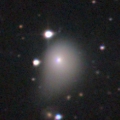
|
Now it is bright as 9.9 mag (Apr. 4, Artyom Novichonok). The brightening
is somewhat slow, but it is expected to brighten up to 6-7 mag in 2014
autumn. It keeps observable in good condition for a long time in the
Northern Hemisphere. It keeps locating low in the Southern Hemisphere.
Date(TT) R.A. (2000) Decl. Delta r Elong. m1 Best Time(A, h)
Apr. 12 15 23.97 40 42.2 1.629 2.333 123 9.7 2:06 (180, 85)
Apr. 19 14 51.88 44 33.4 1.546 2.251 122 9.4 1:07 (180, 81)
|
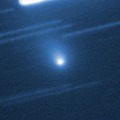
|
Now it is bright as 9.6 mag (Apr. 6, Willian Souza). It will approach to
the sun down to 0.66 a.u. in July, and it is expected to brighten up to
7 mag. Before the perihelion passage, it keeps observable until mid May
in the Northern Hemisphere, or until early June in the Southern
Hemisphere. After the perihelion passage, it will be observable in
excellent condition after late July in the Northern Hemisphere. In the
Southern Hemisphere, it keeps unobservable until early September.
Date(TT) R.A. (2000) Decl. Delta r Elong. m1 Best Time(A, h)
Apr. 12 8 48.79 -20 51.4 0.978 1.657 113 10.1 19:57 ( 9, 34)
Apr. 19 8 13.92 -14 15.6 1.035 1.554 99 10.0 20:05 ( 31, 35)
|
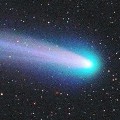
|
It passed only 0.4 A.U. from the earth, and 0.8 A.U. from the sun in
November and December, and brightened up to 4.7 mag (Nov. 28, Juan Jose
Gonzalez). Now it is 11.2 mag (Apr. 7, Carlos Labordena). It keeps
observable until 2014 autumn when the comet fades out.
Date(TT) R.A. (2000) Decl. Delta r Elong. m1 Best Time(A, h)
Apr. 12 18 17.15 -9 29.3 1.492 2.025 106 10.2 4:04 (342, 44)
Apr. 19 18 7.88 -11 23.6 1.474 2.117 116 10.4 3:54 (351, 43)
|
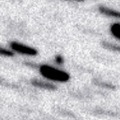
|
The condition in this apparition is bad. It locates low around the
brightest days. Now it is not observable. It will appear in the morning
sky at 13 mag in late July.
Date(TT) R.A. (2000) Decl. Delta r Elong. m1 Best Time(A, h)
Apr. 12 1 10.14 7 38.2 2.723 1.722 2 12.6 4:04 (248,-17)
Apr. 19 1 29.10 9 7.3 2.703 1.705 4 12.5 3:54 (246,-16)
|
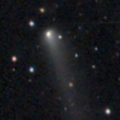
|
Now it is 12.9 mag (Mar. 28, Sandor Szabo). It will brighten up to 13
mag and to be observable in excellent condition from spring to summer.
Date(TT) R.A. (2000) Decl. Delta r Elong. m1 Best Time(A, h)
Apr. 12 14 5.24 -11 49.1 1.602 2.592 168 12.9 0:47 ( 0, 43)
Apr. 19 14 2.21 -11 16.1 1.582 2.585 176 12.8 0:16 ( 0, 44)
|
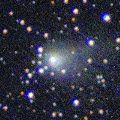
|
First return of a new periodic comet discovered in 1998. It brightened
up to 10 mag at the discovery. Now it is 12.7 mag (Mar. 28, Sandor
Szabo). A bit fainter than originally expected. But in the Northern
Hemisphere, it keeps observable in excellent condition from autumn to
spring. It locates somewhat low in the Southern Hemisphere.
Date(TT) R.A. (2000) Decl. Delta r Elong. m1 Best Time(A, h)
Apr. 12 7 16.05 17 42.7 1.996 2.175 86 12.9 19:57 ( 65, 58)
Apr. 19 7 27.37 16 34.3 2.079 2.185 82 13.1 20:05 ( 70, 53)
|
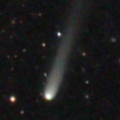
|
Now it is 14.3 mag (Mar. 30, Taras Prystavski). It is expected to
brighten up to 7.5 mag and to be observable in excellent condition from
summer to autumn in 2014 in the Southern Hemisphere. It keeps observable
for a long time in the Southern Hemisphere, although it becomes low
temporarily in May. It keeps unobservable for a while in the Northern
Hemisphere. It will pass extremely close to Mars in 2014 October.
Date(TT) R.A. (2000) Decl. Delta r Elong. m1 Best Time(A, h)
Apr. 12 2 42.58 -25 20.0 3.660 2.953 39 13.2 19:57 ( 73,-21)
Apr. 19 2 45.12 -24 42.1 3.599 2.881 38 13.1 20:05 ( 78,-27)
|
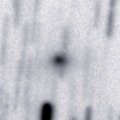
|
It brightened up to 2 mag by unusual major outburst in 2007. It is
coming back now. It will be 14 mag at best by normal prediction. But
actually, it is already very bright as 13.5 mag (Nov. 25, Hidetaka
Sato). Now it is not observable. It will appear in the morning sky in
May.
Date(TT) R.A. (2000) Decl. Delta r Elong. m1 Best Time(A, h)
Apr. 12 0 5.98 7 51.6 2.986 2.060 18 13.4 4:04 (258, -4)
Apr. 19 0 19.97 10 1.0 2.967 2.064 21 13.4 3:54 (256, -2)
|
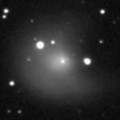
|
New outburst occured in early March. Now it is bright as 13.1 mag (Mar. 12, Chris Wyatt).
Date(TT) R.A. (2000) Decl. Delta r Elong. m1 Best Time(A, h)
Apr. 12 15 54.80 -30 58.6 5.372 6.150 137 13.6 2:36 ( 0, 24)
Apr. 19 15 52.44 -30 59.1 5.302 6.149 144 13.5 2:06 ( 0, 24)
|
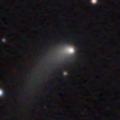
|
Now it is 14.3 mag (Mar. 30, Todd Augustyniak). It keeps 14 mag for a
long time until 2014 summer. It keeps observable in good condition in
the Northern Hemisphere. It keeps unobservable after this in the
Southern Hemisphere.
Date(TT) R.A. (2000) Decl. Delta r Elong. m1 Best Time(A, h)
Apr. 12 3 33.92 48 14.8 2.148 1.665 48 13.9 19:57 (132, 28)
Apr. 19 3 48.77 51 10.2 2.170 1.661 47 13.9 20:05 (136, 26)
|
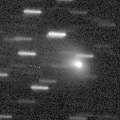
|
It brightened up to 11-12 mag in 2012. Now it is 13.7 mag (Mar. 28,
Sandor Szabo). It will be observable in good condition at 14 mag until
2014 early summer.
Date(TT) R.A. (2000) Decl. Delta r Elong. m1 Best Time(A, h)
Apr. 12 12 26.34 -10 47.9 6.414 7.392 166 13.9 23:03 ( 0, 44)
Apr. 19 12 20.76 -10 15.8 6.481 7.426 158 13.9 22:30 ( 0, 45)
|
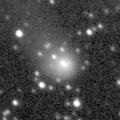
|
Now it is 14.0 mag (Mar. 29, Sandor Szabo). It keeps bright at 13-14 mag for a long time until 2014.
Date(TT) R.A. (2000) Decl. Delta r Elong. m1 Best Time(A, h)
Apr. 12 19 57.51 4 20.7 6.425 6.333 80 14.1 4:04 (302, 43)
Apr. 19 19 56.42 4 18.4 6.328 6.351 86 14.0 3:54 (307, 46)
|
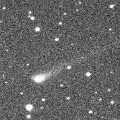
|
Now it is 14.9 mag (Mar. 5, Taras Prystavski). It keeps bright as 13-14 mag for a long time from 2013 to 2014.
Date(TT) R.A. (2000) Decl. Delta r Elong. m1 Best Time(A, h)
Apr. 12 20 28.99 -25 23.5 3.095 3.057 78 14.2 4:04 (317, 15)
Apr. 19 20 36.88 -25 17.5 3.003 3.058 83 14.1 3:54 (319, 17)
|
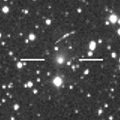
|
Brightening rapidly. Now it is 14.0 mag (Mar. 28, Sandor Szabo). It will
brighten up to 13-14 mag and will be observable in excellent condition
from spring to summer in the Southern Hemisphere. It locates somewhat
low in the Northern Hemispehre.
Date(TT) R.A. (2000) Decl. Delta r Elong. m1 Best Time(A, h)
Apr. 12 8 9.17 -20 36.5 1.578 2.068 104 14.3 19:57 ( 19, 32)
Apr. 19 8 18.23 -19 42.1 1.591 2.038 101 14.2 20:05 ( 26, 31)
|
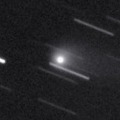
|
Now it is bright as 13.9 mag (Mar. 29, Sandor Szabo). It keeps 13-14 mag
and observable in good condition in the Northern Hemisphere for a long
time from 2013 to 2014. In the Southern Hemisphere, it is not observable
until 2014 autumn.
Date(TT) R.A. (2000) Decl. Delta r Elong. m1 Best Time(A, h)
Apr. 12 0 49.02 52 31.9 4.230 3.584 44 14.5 4:04 (216, 16)
Apr. 19 0 54.87 52 10.6 4.279 3.603 42 14.5 3:54 (217, 17)
|
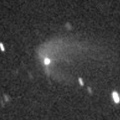
|
Big asteroid discovered in 1906. It suddenly showed the cometary
activity on Dec. 11, 2010, probably due to an impact of a small object.
It has already turned to be stellar.
Date(TT) R.A. (2000) Decl. Delta r Elong. m1 Best Time(A, h)
Apr. 12 2 8.25 5 50.6 4.282 3.309 12 15.0 19:57 (105,-11)
Apr. 19 2 17.04 6 49.4 4.304 3.315 8 15.0 20:05 (110,-15)
|
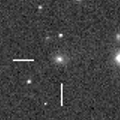
|
It is expected to brighten up to 13 mag and to be observable in good
condition in 2015. Now it is 15.5 mag (Mar. 29, Sandor Szabo). In 2014,
it will be observable at 15 mag in good condition from winter to summer.
Date(TT) R.A. (2000) Decl. Delta r Elong. m1 Best Time(A, h)
Apr. 12 13 52.50 -1 23.8 3.741 4.730 169 15.1 0:34 ( 0, 54)
Apr. 19 13 49.70 -0 55.9 3.697 4.689 169 15.1 0:03 ( 0, 54)
|
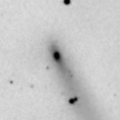
|
Now it is 15.2 mag (Mar. 30, Taras Prystavski), brighter than origianlly
predicted. It will be observable at 14-16 mag for a long time from 2013
to 2014.
Date(TT) R.A. (2000) Decl. Delta r Elong. m1 Best Time(A, h)
Apr. 12 16 20.73 -24 56.9 3.333 4.094 134 15.7 3:02 ( 0, 30)
Apr. 19 16 18.83 -25 5.8 3.276 4.108 141 15.7 2:32 ( 0, 30)
|

|
First return of a new periodic comet which brightened up to 13 mag in
2007. It is expected to brighten up to 13 mag again and observable in
good condition from summer to autumn in 2014. But actually, it is 18.3
mag, much fainter than this ephemeris (Apr. 2, Taras Prystavski).
Date(TT) R.A. (2000) Decl. Delta r Elong. m1 Best Time(A, h)
Apr. 12 21 34.83 -10 15.3 2.849 2.491 59 15.9 4:04 (295, 16)
Apr. 19 21 46.48 -9 31.0 2.759 2.473 63 15.8 3:54 (295, 17)
|
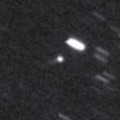
|
Now it is 17.1 mag (Apr. 6, Mitsunori Tsumura). It will approach to the
earth down to 0.06 a.u. from May to June, and it is expected to brighten
up to 11 mag. In the Northern Hemisphere, it keeps observable in
excellent condition until the highlight in late May while the comet will
be brightening rapidly. In the Southern Hemisphere, it is not
observable now. But it will be observable in mid May. Then it keeps
observable in excellent condition at the highlight and after that while
the comet will be fading.
Date(TT) R.A. (2000) Decl. Delta r Elong. m1 Best Time(A, h)
Apr. 12 7 16.89 71 56.2 0.422 1.029 81 16.2 19:57 (166, 50)
Apr. 19 7 36.24 71 8.7 0.371 1.000 78 15.8 20:05 (164, 50)
|
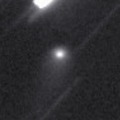
|
It brightened up to 14.0 mag from spring to summer in 2013 (June 11,
Sandor Szabo). Now it is 15.2 mag, much brighter than origianlly
predicted (Mar. 28, Sandor Szabo). In the Northern Hemisphere, it will
be observable at 15-16 mag in excellent condition until spring. It
locates somewhat low in the Southern Hemisphere.
Date(TT) R.A. (2000) Decl. Delta r Elong. m1 Best Time(A, h)
Apr. 12 12 18.88 33 38.9 3.711 4.480 135 16.0 22:55 ( 0, 89)
Apr. 19 12 9.10 34 38.9 3.822 4.520 128 16.1 22:18 ( 0, 90)
|
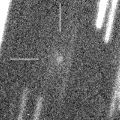
|
Recovered at 18.7 mag on Apr. 9 by Martin Masek. It brightened up to 9
mag at the discovery in 2005. It will approach to the sun down to 0.8
a.u. on May 29. However, it will brighten up to 14 mag at best. In this
apparition, it keeps observable in the morning sky all through the
period. But it locates extremely low around the perihelion passage in
the Northern Hemisphere.
Date(TT) R.A. (2000) Decl. Delta r Elong. m1 Best Time(A, h)
Apr. 12 20 51.77 -14 39.1 0.893 1.098 70 16.7 4:04 (306, 20)
Apr. 19 21 34.90 -12 18.8 0.868 1.035 66 16.0 3:54 (299, 17)
|
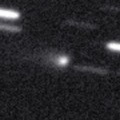
|
Now it is 16.0 mag (Apr. 5, R. Naves, M. Campas). It is expected to
brighten up to 6 mag in 2014 autumn. At this time, it keeps observable
while brightening gradually until April when it becomes 16 mag.
Date(TT) R.A. (2000) Decl. Delta r Elong. m1 Best Time(A, h)
Apr. 12 4 50.04 18 47.2 3.379 2.868 51 16.2 19:57 ( 94, 29)
Apr. 19 4 51.02 18 36.8 3.395 2.779 45 16.1 20:05 ( 98, 22)
|
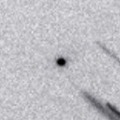
|
Now it is 15.8 mag (Mar. 28, Sandor Szabo). It will approach to the
earth down to 0.68 a.u., brighten up to 16 mag, and will be observable
in excellent condition in spring.
Date(TT) R.A. (2000) Decl. Delta r Elong. m1 Best Time(A, h)
Apr. 12 10 42.93 1 51.2 0.750 1.645 139 16.3 21:20 ( 0, 56)
Apr. 19 10 37.01 -1 52.0 0.796 1.648 132 16.4 20:47 ( 0, 53)
|
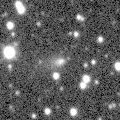
|
It brightened up to 14.7 mag in winter (Jan. 19, Taras Prystavski). Now
it is fading. It has already faded down to 16.3 mag (Mar. 30, Taras
Prystavski). It will be fainter than 18 mag in June.
Date(TT) R.A. (2000) Decl. Delta r Elong. m1 Best Time(A, h)
Apr. 12 6 52.54 27 1.8 1.686 1.805 79 16.3 19:57 ( 86, 58)
Apr. 19 7 10.07 25 52.6 1.756 1.818 77 16.4 20:05 ( 87, 54)
|
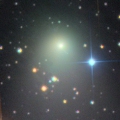
|
It became much brighter than expected, and reached up to 8.5 mag (Aug.
15, Alexandre Amorim). Now it is fading rapidly. It has already faded
down to 16.3 mag (Mar. 30, Taras Prystavski). In the Southern
Hemisphere, it will keep observable in good condition for a long time
until 2014 summer when the comet fades out. It will never be observable
again in the Northern Hemisphere.
Date(TT) R.A. (2000) Decl. Delta r Elong. m1 Best Time(A, h)
Apr. 12 16 40.25 -71 51.6 2.896 3.370 109 16.5 3:22 ( 0,-17)
Apr. 19 16 23.43 -71 43.3 2.895 3.440 114 16.6 2:38 ( 0,-17)
|
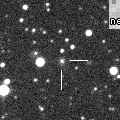
|
Now it is 16.0 mag (Mar. 30, Taras Prystavski). It keeps 16 mag for a
long time until 2015 summer. It keeps observable in good condition in
the Northern Hemisphere. It becomes observable only after 2015 in the
Southern Hemisphere.
Date(TT) R.A. (2000) Decl. Delta r Elong. m1 Best Time(A, h)
Apr. 12 5 27.74 52 8.2 4.189 3.894 66 16.5 19:57 (131, 46)
Apr. 19 5 38.53 52 3.9 4.237 3.867 61 16.5 20:05 (132, 43)
|
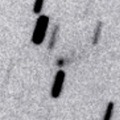
|
Now it is 16.8 mag (Apr. 5, J. F. Hernandez). It keeps 16.5 mag until June.
Date(TT) R.A. (2000) Decl. Delta r Elong. m1 Best Time(A, h)
Apr. 12 14 26.84 -9 42.5 1.183 2.163 163 16.7 1:08 ( 0, 45)
Apr. 19 14 20.86 -10 30.4 1.158 2.156 171 16.7 0:35 ( 0, 44)
|
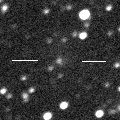
|
Now it is 17.9 mag (Mar. 9, W. Hasubick). Distant object, but it keeps observable at 14 mag for a long time from 2015 to 2016.
Date(TT) R.A. (2000) Decl. Delta r Elong. m1 Best Time(A, h)
Apr. 12 19 18.14 -3 47.1 7.175 7.265 91 16.9 4:04 (319, 43)
Apr. 19 19 19.49 -3 29.4 7.036 7.232 97 16.8 3:54 (324, 45)
|
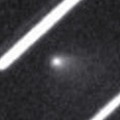
|
It brightened up to 15.1 mag at opposition in March (Mar. 11, Catalina
Sky Survey). Now it is fading rapidly. It has already faded down to 16.8
mag (Apr. 5, J. F. Hernandez). It will be fainter than 18 mag in May.
Date(TT) R.A. (2000) Decl. Delta r Elong. m1 Best Time(A, h)
Apr. 12 11 24.16 27 11.7 1.313 2.139 134 16.9 21:59 ( 0, 82)
Apr. 19 10 56.33 29 47.2 1.474 2.181 122 17.2 21:05 ( 0, 85)
|
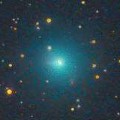
|
It brightened very rapidly, and brightened up to 10.5 mag from autumn to
winter. Now it is fading. It has already faded down to 17.3 mag (Mar.
23, A. Klotz, F. Kugel). However, Sandor Szabo reported it was visible
visually at 13.5 mag on Mar. 28. In the Northern Hemisphere, it keeps
observable in excellent condition until May when it becomes fainter than
18 mag. It will not be observable after this in the Southern
Hemisphere.
Date(TT) R.A. (2000) Decl. Delta r Elong. m1 Best Time(A, h)
Apr. 12 4 39.49 35 45.6 2.508 2.062 52 17.0 19:57 (113, 35)
Apr. 19 4 59.50 35 46.3 2.605 2.106 50 17.1 20:05 (114, 32)
|
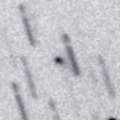
|
Now it is 17.5 mag (Apr. 5, J. F. Hernandez). It keeps 17 mag for a long
time from 2014 to 2015. It is observable in excellent condition in the
Northern Hemisphere. It is observable only until 2014 summer in the
Southern Hemisphere.
Date(TT) R.A. (2000) Decl. Delta r Elong. m1 Best Time(A, h)
Apr. 12 16 17.12 22 17.3 3.611 4.289 126 17.1 2:58 ( 0, 77)
Apr. 19 16 15.40 24 10.7 3.554 4.263 129 17.1 2:29 ( 0, 79)
|
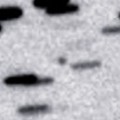
|
Now it is 17.0 mag (Apr. 5, J. F. Hernandez). It keeps 17-18 mag for a long time from 2014 to 2016.
Date(TT) R.A. (2000) Decl. Delta r Elong. m1 Best Time(A, h)
Apr. 12 14 48.69 -12 43.9 4.779 5.720 157 17.2 1:30 ( 0, 42)
Apr. 19 14 40.13 -12 31.6 4.719 5.702 166 17.1 0:54 ( 0, 42)
|

|
Now it is 17.5 mag (Apr. 5, N. James). It keeps observable at 18 mag for
a long time from 2013 to 2016. It keeps locating high in the Northern
Hemisphere. It keeps locating very low in the Southern Hemipshere.
Date(TT) R.A. (2000) Decl. Delta r Elong. m1 Best Time(A, h)
Apr. 12 19 13.99 39 3.8 6.516 6.522 85 17.2 4:04 (251, 68)
Apr. 19 19 11.64 40 28.5 6.449 6.516 89 17.2 3:54 (246, 71)
|
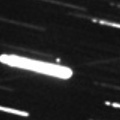
|
Now it is 17.4 mag (Jan. 27, iTelescope Observatory, Siding Spring). It
keeps 17-18 mag for a long time from 2013 to 2014. It is observable in
excellent condition in the Southern Hemisphere. It is not observable in
the Northern Hemisphere.
Date(TT) R.A. (2000) Decl. Delta r Elong. m1 Best Time(A, h)
Apr. 12 12 42.24 -59 21.3 3.990 4.682 128 17.2 23:18 ( 0, -4)
Apr. 19 12 23.10 -59 14.7 3.983 4.684 129 17.2 22:32 ( 0, -4)
|
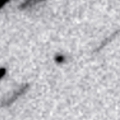
|
It was observed at 17.5 mag in early 2013. It will be observable at 17.5 mag again from spring to summer in 2014.
Date(TT) R.A. (2000) Decl. Delta r Elong. m1 Best Time(A, h)
Apr. 12 19 23.73 -13 17.7 2.553 2.763 91 17.4 4:04 (324, 34)
Apr. 19 19 29.77 -13 3.6 2.478 2.777 96 17.4 3:54 (327, 35)
|
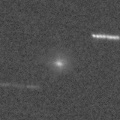
|
It brightened up to 13.5 mag in early March (Mar. 1, Taras Prystavski).
It keeps observable in the evening sky for a while. But it is fading
rapidly now. It has already faded down to 17.2 mag (Mar. 29, Taras
Prystavski).
Date(TT) R.A. (2000) Decl. Delta r Elong. m1 Best Time(A, h)
Apr. 12 5 20.60 15 41.8 1.277 1.146 58 17.5 19:57 ( 86, 34)
Apr. 19 5 55.83 16 36.2 1.364 1.234 60 18.2 20:05 ( 87, 35)
|
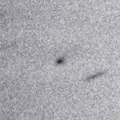
|
Now it is 17.9 mag (Apr. 6, Ken-ichi Kadota). It keeps 17 mag for a long time until 2015.
Date(TT) R.A. (2000) Decl. Delta r Elong. m1 Best Time(A, h)
Apr. 12 10 49.22 -7 26.8 2.664 3.513 142 17.6 21:27 ( 0, 48)
Apr. 19 10 47.32 -6 57.2 2.710 3.498 135 17.6 20:57 ( 0, 48)
|
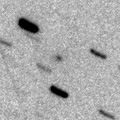
|
It approached to the earth down to 0.7 a.u., and brightened up to 17.2
mag in February and March (Feb. 24, A. Klotz, F. Kugel). Now it is 17.8
mag (Mar. 16, N. James). It is observable in excellent condition in the
Northern Hemisphere. It locates very low in the Southern Hemisphere.
Date(TT) R.A. (2000) Decl. Delta r Elong. m1 Best Time(A, h)
Apr. 12 8 2.64 25 12.3 0.761 1.318 95 17.6 19:57 ( 63, 71)
Apr. 19 8 32.99 21 59.1 0.821 1.366 96 17.9 20:05 ( 58, 68)
|
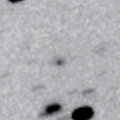
|
Now it is 18.1 mag (Mar. 29, M. Jaeger, W. Vollmann, E. Prosperi, S.
Prosperi). It keeps 18 mag for a very long time from 2013 to 2018. It
locates high in the Southern Hemisphere. But it locates somewhat low in
the Northern Hemisphere.
Date(TT) R.A. (2000) Decl. Delta r Elong. m1 Best Time(A, h)
Apr. 12 10 58.09 -17 46.0 8.491 9.322 144 17.8 21:36 ( 0, 37)
Apr. 19 10 56.98 -17 26.3 8.541 9.316 138 17.8 21:07 ( 0, 38)
|
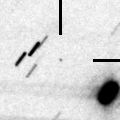
|
Now it is 17.6 mag (Mar. 28, A. Maury, J.-F. Soulier, T. Noel, J.-G.
Bosch). It keeps 18 mag from spring to summer. It is observable in good
condition in the Southern Hemisphere. It is not observable in the
Northern Hemisphere.
Date(TT) R.A. (2000) Decl. Delta r Elong. m1 Best Time(A, h)
Apr. 12 16 57.78 -65 9.8 0.641 1.378 112 17.9 3:39 ( 0,-10)
Apr. 19 17 10.01 -66 0.9 0.646 1.407 115 17.9 3:23 ( 0,-11)
|
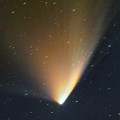
|
It passed the perihelion on 2013 Mar. 10, and brightened up to 0-1 mag.
Now it is fading. It has already faded down to 17.6 mag (Apr. 2, A.
Diepvens). It will keep 16-17 mag until spring. It is not observable in
the Southern Hemisphere.
Date(TT) R.A. (2000) Decl. Delta r Elong. m1 Best Time(A, h)
Apr. 12 17 11.32 36 28.4 5.248 5.665 109 17.9 3:52 (180, 89)
Apr. 19 17 6.82 37 10.8 5.271 5.735 112 18.0 3:20 (180, 88)
|

|
Now it is 18.4 mag (Mar. 12, W. Hasubick). It keeps 18 mag for a long time from 2013 to 2014.
Date(TT) R.A. (2000) Decl. Delta r Elong. m1 Best Time(A, h)
Apr. 12 16 18.44 13 57.2 6.825 7.515 130 17.9 2:59 ( 0, 69)
Apr. 19 16 14.22 14 53.7 6.773 7.518 135 17.9 2:28 ( 0, 70)
|
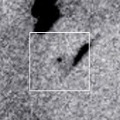
|
Now it is 19.4 mag (Apr. 4, A. Waszczak). First return of a new periodic
comet which brightened up to 13 mag in outburst in 2008. It will be
observable in good condition from spring to summer. However, it will be
only 19-20 mag at best in this apparition.
Date(TT) R.A. (2000) Decl. Delta r Elong. m1 Best Time(A, h)
Apr. 12 12 21.24 15 46.1 1.575 2.503 151 19.5 22:58 ( 0, 71)
Apr. 19 12 17.01 15 51.5 1.597 2.489 145 19.5 22:27 ( 0, 71)
|
|












































No comments:
Post a Comment